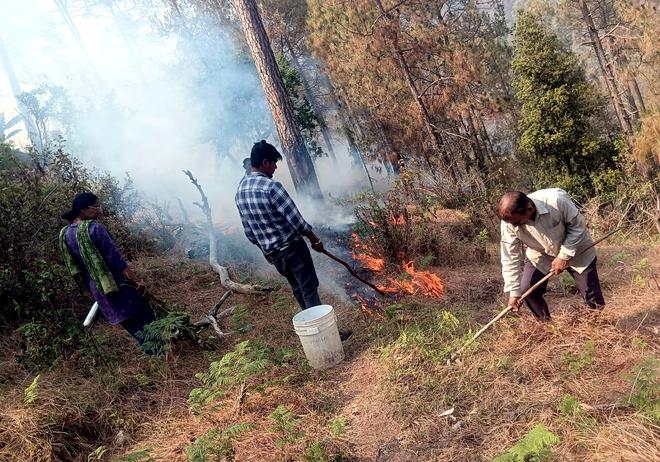It is like a national duty. We have to douse the fires and save our forests. We are the same as the army men deployed on the international border to save the country, with the difference being they have guns to protect the border, and we have a tree branch to beat out the flame,” says Shiv Rawat, a young forest ranger in Uttarakhand.
Rawat, in his early thirties, is one of hundreds of forest department workers deployed to douse forest fires when they are reported in Uttarakhand. The summer of 2024 in particular has been taxing, with panic calls about forest fires almost every day. Rawat says that the forest fire season starts in the month of November, but this year incidences have increased since February. “It is my sixth year of service, and I have never seen such a large number of forest fire complaints,” he says.
Forest fires in Uttarakhand have now engulfed an area of 1438 hectares, with 1065 incidents between November 1 last year and May 13, 2024. Five people have died. However, State wildlife department officials have claimed the situation is under control. That said, unlike forest firefighters in states like Kerala who are armed with fire beaters and blowers to clear dry leaves and other fuel load, Rawat says here an iron rake is used to create fire lines. Both the firefighters and villagers depend on green, sap-filled branches to douse the fire. In addition to the difficult terrain, they don’t have sufficient water either, for other forms of relief. “We are at god’s mercy and wait for fresh rains that continue for at least three to four days,” he says.

Dealing with misconceptions
Swapnil Anirudha, the divisional forest officer posted in Garhwal, says that Uttarakhand was always susceptible to forest fires. “But comparing last year’s (22-23) to this year’s (23-24) data gives us the wrong idea. Last year, we were lucky enough to get rainfall in regular intervals,” he says. “We haven’t had rainfall so far this year, so we are seeing continuous forest fires.” As in other states, most forest fires in Uttarakhand are anthropogenic or caused by human activity (both deliberate and negligent), he says. “Due to growing wheat cultivation, farmers will engage in stubble burning, which when left unattended starts spreading.” Another reason is leopard or tiger attacks. “If there is a lot of vegetation, I would be inclined to burn and clear them for better visibility. But burning and leaving the vegetation unattended helps the fire to spread out,” he continues.
Locals who invest in cattle grazing also believe that burning dry leaves will aid in quick growth of grass. “In some villages, with no proper roads, the rain makes the tracks slippery. Many decide to set fire to the tracks to clear all the chir pine needles (Uttarakhand is known for its chir pine forests). And another misconception locals have is that the smoke from fires can trigger good rainfall,” Anirudha observes. Seema Nautiyal (name changed), 47, is one such local from Dharasu Bend in Uttarkashi district. She is wary of legal action after being pulled up by a forest ranger for burning wild grass near her house. A small patch of forest in this area has been on fire since November 2023. “I set fire to the shrubs to keep wild animals like leopards away and to get good grass for my livestock,” she explains, insisting that the fires are normal due to “no rainfall this season and dry pine needles and other leaves,” she shares via a phone call.
Giving locals incentives
In a press statement, the Uttarakhand Forest Department said any kind of negligence regarding forest fire will not be tolerated, with action recently taken against 17 personnel for negligence. According to Additional Principal Chief Conservator of Forest Nishant Verma, more than 389 cases were registered against people for triggering forest fires across the State, with 329 cases against anonymous people, and 60 against specified individuals. “Most of these fires are man-made. We are taking every action to bring the cases down, and communities are also being engaged,” he added.
Anirudha says they have engaged close to 200 forest fire watchers, with a team of around 500 people to tackle forest fires. “The geographical expanse of my district is around 5,000 sq. km. Everyone gets 50 sq. km., which is a huge area when you think of mountainous terrain. If people continue to remain unaware, this will remain a losing battle. We are trying for community involvement with incentives,” he explains. One of them is for pine needle collection, as these do not decompose and are considered fire agents. The government of Uttarakhand has recently increased the rate of pine needle collection or the ‘Pirul Lao-Paise Pao’ scheme from ₹3 to ₹50 per kg. That said, the season when pines shed needles is almost over, so the success of this scheme is still uncertain.
Another challenge is the shortage of manpower. Many forest department officials were engaged in election duties, and a forest officer from the Pauri Garhwal range admits that the department was working with limited staff and resources. “Thankfully, the fresh rains have brought the situation a bit under control,” he says.
Prioritising certain jungles
A.G. Ansari, a wildlife expert and member of a tiger conservation foundation in Uttarakhand, shares that there are two different alerts: one for large forest fires and another for localised forest fires. “The large is one where there are more vulnerable zones, and the area affected is large. So once such areas are contained, we move on to other areas. Then comes prioritising certain jungles with a higher ecological value.” He, too, stresses that community engagement is a must to control a fire. “There are hundreds of van panchayats across the State which manage the forests and the government also acknowledges it. To increase awareness using communities the government has tried to incentivise these van panchayats through different ways,” Ansari continues. In fact, there have been instances of women joining the firefighting drive. ‘Jungle ke Dost’ is a WhatsApp group with about 300 women who are said to assist during forest fires.
Affecting livelihoods
That these fires affect farmers and those reliant on the forest for essentials goes without saying. “There was a fire in the forest above my village and it has affected our farming because I could not sow tomatoes. Same with other farmers too,” says Lokesh Verma, a farmer and homestay owner in Nainital’s Chamfi, a small tourist town. “We are highly dependent on firewood, which we cannot access now. Many families dependent on forest produce like Mahua, leaves and firewood are facing a crisis.” But Banshi Dhar Tiwari, the director of information in Uttarakhand insists that forest fires have not affected either tourism or the Char Dham Yatra this year.
With inputs from Ishita Mishra (Delhi).
The author is a independent investigative journalist who has won several international awards and is currently in London on the Chevening fellowship.







